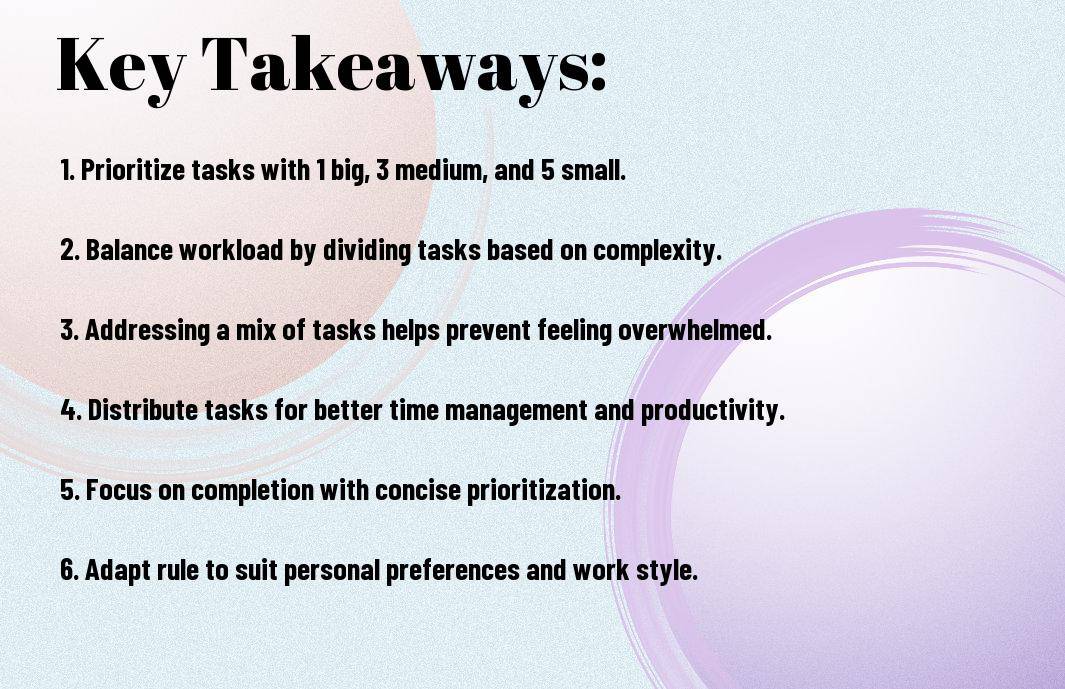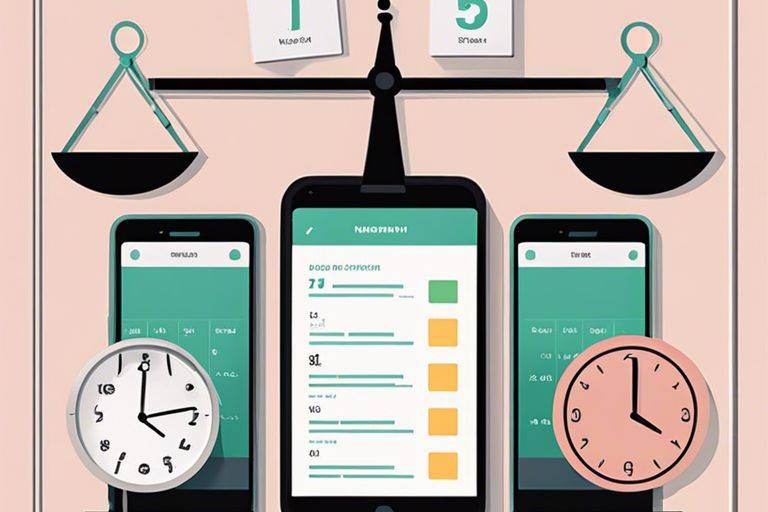
Newsletter Subscribe
Enter your email address below and subscribe to our newsletter

Enter your email address below and subscribe to our newsletter

The 1-3-5 Rule! With the ever-increasing demands of modern life, finding a way to effectively prioritize tasks and manage time is vital. One popular strategy that can help individuals achieve this balance is the 1-3-5 Rule. This simple yet powerful method provides a structured approach to task management that can increase productivity and reduce overwhelm.
The 1-3-5 Rule involves identifying and focusing on 1 big task, 3 medium tasks, and 5 small tasks for the day. This framework encourages individuals to tackle a mix of tasks of varying complexity, ensuring that both important projects and everyday responsibilities are addressed. By implementing the 1-3-5 Rule into your daily routine, you can enhance your efficiency, prioritize effectively, and achieve a better balance between tasks of different complexities.

Assuming you are looking to streamline your productivity and tackle tasks efficiently, the 1-3-5 Rule is a powerful tool to assist you. The rule revolves around the concept of prioritizing your daily tasks by focusing on one big task, three medium tasks, and five small tasks. By breaking your to-do list down into these categories, you can create a balanced approach to task completion across different levels of complexity.
Behind the 1-3-5 Rule lies a fundamental psychological principle that highlights the importance of setting realistic limits to maximize productivity. Research has shown that our brains can only effectively handle a certain number of tasks at a time. By setting limits on the number of tasks in each category, you are reducing cognitive overload and decision fatigue, allowing your brain to focus more effectively on the tasks at hand.
It is vital to understand that by limiting the number of tasks in each category, you are not only improving your ability to focus but also increasing your likelihood of completing tasks. This structured approach helps prevent feeling overwhelmed by a lengthy to-do list and ensures that you are making meaningful progress towards your goals.
Despite the overwhelming nature of tasks that need to be completed daily, the 1-3-5 rule provides a structured approach to help achieve a balance in task completion. By categorizing tasks into one big, three medium, and five small tasks, individuals can effectively prioritize and manage their workload for the day. Setting up your 1-3-5 list involves careful consideration of task complexity and importance.
Any successful day begins with identifying your single most important task. This task should be the one that, when accomplished, will have the most significant impact on your day or overall goals. To identify this task, consider the urgency, importance, and potential outcomes of each item on your to-do list. It may require critical thinking and introspection to determine which task takes precedence above all others.
One crucial step in setting up your 1-3-5 list is selecting your three medium-complexity tasks. These tasks should require a moderate amount of time and effort to complete but should not be as demanding as your single most important task. They should contribute to your overall progress and help you advance toward your larger goals without overwhelming you.
Understanding the significance of these tasks can help you allocate your energy and focus efficiently throughout the day. While they may not be as pressing as your top priority, they are still necessary for your productivity and success.
Choosing your five small, easily achievable tasks is the final step in setting up your 1-3-5 list. These tasks should be quick wins that you can accomplish relatively easily. They could include responding to emails, making a phone call, or organizing your workspace. While these tasks may seem insignificant on their own, completing them can provide a sense of accomplishment and momentum to tackle more significant tasks.
The 1-3-5 rule is designed to help individuals prioritize their tasks effectively by balancing the complexity and importance of each task. By following this structured approach, you can enhance your productivity, reduce feelings of overwhelm, and make significant progress towards your goals.

All successful task completion hinges on effective prioritization strategies. By ranking tasks based on their importance and urgency, individuals can ensure that they are focusing their time and energy on the most critical activities. The 1-3-5 rule provides a simple framework for prioritizing tasks by selecting one big task, three medium tasks, and five small tasks to accomplish each day. This approach helps maintain a balance between tackling significant projects and completing smaller, more manageable tasks.
On your quest to prioritize tasks effectively, consider utilizing techniques such as the Eisenhower Matrix, ABCDE method, or MoSCoW method. The Eisenhower Matrix categorizes tasks based on their importance and urgency, helping you identify what needs immediate attention versus what can be delegated or eliminated. The ABCDE method involves assigning a priority level (A-E) to each task, ensuring that you focus on high-priority items first. The MoSCoW method categorizes tasks as Must-haves, Should-haves, Could-haves, and Won’t-haves, guiding you in determining what is important for task completion.
For optimal task management, it’s crucial to be flexible and willing to adjust priorities as needed throughout the day. Unexpected events or new information may arise, necessitating a shift in focus to address pressing matters. It’s important to regularly reassess your task list and reprioritize items based on changing circumstances. By staying agile and adaptable, you can maximize your productivity and ensure that you are addressing the most critical tasks at any given time.
It’s paramount to prioritize self-care and well-being amidst shifting priorities throughout the day. Remember to incorporate breaks, exercise, and moments of relaxation to maintain your focus and productivity levels. Striking a balance between work and personal life is key to long-term success and overall well-being.
Keep in mind that in a corporate setting, the 1-3-5 Rule can be a valuable tool to help employees prioritize tasks effectively. Managers can encourage their team members to designate one big task, three medium tasks, and five small tasks for the day. This structured approach can enhance productivity and ensure that both important projects and daily responsibilities are completed in a timely manner.
Various work environments such as remote or hybrid setups require customization of the 1-3-5 Rule to suit the unique challenges and opportunities they present. In remote settings, where distractions can be high and communication may be more challenging, individuals may need to adjust their daily task list to account for these factors. Hybrid work environments, on the other hand, may necessitate a flexible approach that considers both in-office and remote work requirements.
Understanding the specific dynamics of remote and hybrid work setups is crucial in tailoring the 1-3-5 Rule to maximize productivity and efficiency in these environments. By adapting the rule to address the nuances of remote work, such as incorporating more frequent check-ins or leveraging digital tools for collaboration, employees can better navigate the complexities of these work environments while maintaining a focus on task completion.
The 1-3-5 Rule can be particularly impactful in a startup or high-growth environment where agility and rapid progress are paramount. In such fast-paced settings, individuals often juggle multiple responsibilities and projects simultaneously. By adhering to the rule, startup employees can ensure that they allocate their time and energy effectively, balancing ambitious growth goals with daily operational tasks.
HighGrowth companies can benefit greatly from the structured approach of the 1-3-5 Rule, as it helps maintain a sense of direction and purpose amidst the whirlwind of opportunities and challenges that come with rapid expansion. By focusing on one major goal, three medium tasks, and five small activities each day, employees in high-growth environments can foster a culture of productivity and achievement.

Many individuals face challenges when trying to implement the 1-3-5 rule effectively. One common obstacle is dealing with interruptions and distractions that can derail your task completion. With the constant influx of emails, messages, and unexpected requests, it can be challenging to stay focused on your 1 big task, 3 medium tasks, and 5 small tasks for the day. To overcome this, consider setting aside specific times for checking messages and emails, and communicate to colleagues and family members when you need uninterrupted time to focus on your tasks. Implementing strategies like time blocking and using productivity tools can also help minimize distractions and increase your productivity.
With the rise of open-office layouts and constant connectivity through technology, interruptions and distractions have become more prevalent in the workplace. One effective way to combat interruptions is by setting clear boundaries with colleagues and establishing designated focus time. Using tools like noise-cancelling headphones or setting up a quiet workspace can also help minimize distractions and improve your ability to concentrate on tasks. Additionally, practicing mindfulness and staying present in the moment can train your brain to refocus quickly after an interruption, increasing your overall productivity.
An crucial aspect of mastering the 1-3-5 rule is learning how to adjust when tasks take longer than anticipated. When faced with this challenge, prioritize the remaining tasks based on their importance and deadline, and consider delegating or postponing non-urgent tasks to accommodate the extended time needed for the current task. Be flexible in your approach, and don’t be afraid to reassess your daily priorities to ensure you stay on track with your overall goals.
Resisting the Urge to Overcommit
One common pitfall many people encounter is the temptation to take on too many tasks, leading to overwhelm and decreased productivity. To resist the urge to overcommit, be realistic about what you can accomplish in a day and prioritize tasks based on their impact on your long-term goals. Bear in mind, quality over quantity is key to achieving success in task management.
It’s crucial to recognize your limits and set boundaries to prevent burnout and ensure you can consistently deliver high-quality work. Practice saying no to tasks that do not align with your priorities and delegate responsibilities when necessary to maintain a healthy workload. By setting realistic expectations for yourself and others, you can prevent overcommitting and maintain a balanced workload that supports your productivity and well-being.
They are various digital task management tools available that can assist in implementing the 1-3-5 rule effectively. These tools allow users to input tasks, assign priorities, set deadlines, and track progress easily. With features like reminders and notifications, users can stay on top of their tasks and ensure they are completing the right number of tasks at each level of complexity.
On the flip side, for those who prefer a more tactile approach or need a break from screens, analog methods can be just as effective in supporting the 1-3-5 rule. Tools like paper planners, sticky notes, and whiteboards provide a tangible way to visually organize tasks and priorities without relying on digital technology.
Understanding the preferences and needs of individuals is crucial when recommending tools and technologies to support the 1-3-5 rule. While digital task managers offer convenience and efficiency, analog methods can cater to those who thrive in a more traditional and hands-on work environment or simply need a break from the digital world.
Project managers and teams already using project management systems can integrate the 1-3-5 rule seamlessly by incorporating it into their existing processes. By assigning one big task, three medium tasks, and five small tasks to team members, project managers can ensure a balanced workload distribution that aligns with the principles of the rule.
Methods for integrating the rule into existing project management systems may include customizing task fields to reflect the levels of complexity, setting up automated reminders for task completion, and providing training to team members on how to leverage the rule within the project management software. By adapting existing systems to incorporate the 1-3-5 rule, teams can optimize their task management practices for better productivity and efficiency.

The fundamental step in evaluating the impact of the 1-3-5 Rule on productivity is to conduct a self-assessment of your progress. The 1-3-5 method encourages individuals to prioritize tasks by selecting one big task, three medium tasks, and five small tasks daily. Keep a record of the tasks completed within each category and compare them against your initial goals. By regularly reviewing your accomplishments, you can gauge your productivity levels and make necessary adjustments to improve your efficiency.
When assessing the impact of the 1-3-5 Rule on productivity, it’s crucial to seek feedback from both teams and management to gain a comprehensive perspective. Seeking input from colleagues and supervisors can provide valuable insights into the effectiveness of the strategy within the team dynamic and organizational goals. Their feedback can help identify areas of improvement, potential roadblocks, or even untapped opportunities for further productivity enhancement.
Presently, the 1-3-5 Rule stands out as a valuable strategy for effectively managing tasks of varying complexity levels. By breaking down daily priorities into one big task, three medium tasks, and five small tasks, individuals can achieve a balanced approach to task completion. This method allows for a mix of quick wins alongside more time-consuming projects, promoting productivity and focus throughout the day. To learn more about how the 1-3-5 Rule can transform your daily priorities, visit How the 1-3-5 Rule Can Transform Your Daily Priorities.
A: The 1-3-5 Rule is a time management strategy designed to help individuals balance task completion across different levels of complexity.
A: The rule involves choosing 1 big task, 3 medium tasks, and 5 small tasks to focus on each day, ensuring a balanced approach to task completion.
A: The rule helps individuals prioritize their tasks, manage their time effectively, and maintain a sense of accomplishment by balancing tasks of varying levels of difficulty.
A: Start by making a list of tasks you need to complete, categorize them as big, medium, or small, and then choose 1 big task, 3 medium tasks, and 5 small tasks to focus on for the day.
A: Yes, the 1-3-5 Rule is flexible and can be tailored to suit individual preferences and work styles. Feel free to adjust the number of tasks based on your workload and priorities.
A: If you have multiple big tasks, prioritize them based on importance and deadline. You can choose to focus on one big task at a time or break them down into smaller, manageable chunks.
A: Keep a task journal or use a task management tool to track your daily accomplishments and stay motivated. Celebrate small victories to stay inspired and focused on your goals.
Deep Work – Cal Newport’s Secrets to Maximizing Focus on Demanding Tasks
Biological Prime Time – Scheduling Tasks When Energy Is Highest for Peak Productivity
Reduce Digital Distractions with Cal Newport’s Strategy- Digital Minimalism
Eisenhower Matrix – Dwight D. Eisenhower’s Strategy to Prioritize Tasks by Urgency and Importance
80/20 Rule (Pareto Principle) – Vilfredo Pareto’s Technique to Focus on High-Yield Tasks